Archive:Travel agency and tour operator statistics - NACE Rev. 2
This Statistics Explained article is outdated and has been archived - for recent articles on structural business statistics see here.
- Data from October 2015. Most recent data: Further Eurostat information, Main tables and Database.
This article presents an overview of statistics for the travel agency and tour operator reservation and related service activities sector in the European Union (EU), as covered by NACE Rev. 2 Division 79, hereafter referred to as travel agency and related services. It belongs to a set of statistical articles on 'Business economy by sector'.
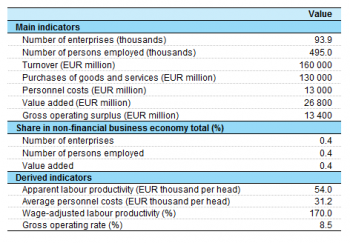
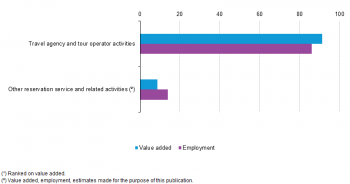
(% share of sectoral total) - Source: Eurostat (sbs_na_1a_se_r2)



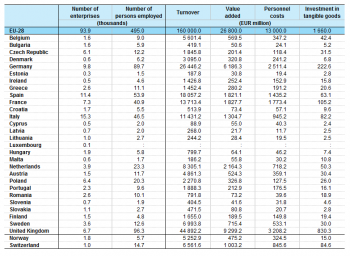


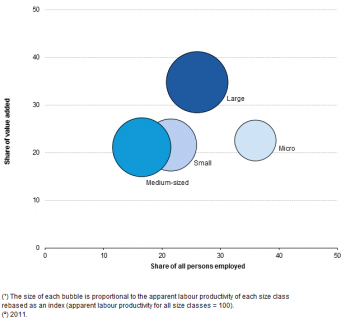
(% share of sectoral total) - Source: Eurostat (sbs_sc_1b_se_r2)

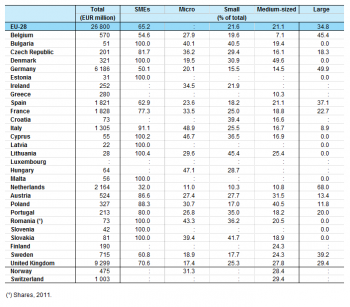
Main statistical findings
Structural profile
There were 93.9 thousand enterprises operating within the travel agency and related services (Division 79) sector in the EU-28 in 2012. Together they employed 495 thousand persons, equivalent to 0.4 % of the total workforce in the non-financial business economy (Sections B to J and L to N and Division 95) and 3.7 % of those employed within administrative and support services (Section N). Travel agency and related services generated EUR 26.8 billion of value added which was 0.4 % of the non-financial business economy total or 6.3 % of the added value for administrative and support services. As such, in both employment and value added terms, travel agency and related services were the smallest of the six NACE divisions that form the administrative and support services sector. Given the nature of travel agency and related services it is not surprising to find that they had relatively high turnover, some EUR 160 billion across the EU-28 in 2012, which was equivalent to 0.6 % of the non-financial business economy total or 18.2 % of the turnover generated within administrative and support services.
The somewhat higher share of non-financial business economy value added compared with employment for the travel agency and related services sector meant that the apparent labour productivity of EUR 54.0 thousand per person employed in this sector in 2012 was slightly above the non-financial business economy average of EUR 46.2 thousand and also much higher than the administrative and support services average of EUR 32.0 thousand. Average personnel costs within the EU-28’s travel agency and related services sector were EUR 1 200 per employee lower than the non-financial business economy average, as they stood at EUR 31.2 thousand per employee in 2012, considerably above the average for administrative and support services (EUR 23.1 thousand per employee). The wage-adjusted labour productivity ratio for EU-28 travel agency and related services in 2012 was 170.0 %, considerably higher than the non-financial business economy average (142.7 %) or the administrative and support services average (137.0 %).
The gross operating rate (the relation between the gross operating surplus and turnover) is one measure of operating profitability; it stood at 8.5 % for the EU-28’s travel agency and related services sector in 2012, which was slightly lower than the non-financial business economy average (9.4 %) and considerably lower than the administrative and support services average (15.4 %). Indeed, the gross operating rate for travel agency and related services was the second lowest among the six NACE divisions within administrative and support services.
Sectoral analysis
The EU-28 travel agency and related services sector can be divided into two subsectors, the largest of which — by far — was the travel agency and tour operator activities subsector (Group 79.1). It accounted for 91.3 % of sectoral value added in 2012 and for 86.1 % of sectoral employment; the residual shares being attributed to other reservation services and related activities (Group 79.9). Given the relative weight of the travel agency and tour operator activities subsector there was little difference between it and the whole of the travel agency and related services sector for a range of productivity and profitability measures.
The EU-28’s travel agency and tour operator activities subsector recorded fairly higher apparent labour productivity (EUR 57.0 thousand per person employed in 2012) than that recorded for other reservation services and related activities (EUR 34.0 thousand per person employed in 2011); both subsectors had apparent labour productivity ratios that were above the administrative and support service activities average (EUR 32.0 thousand per person employed in 2012). EU-28 average personnel costs for the travel agency and tour operator activities subsector were EUR 31.7 thousand per employee in 2012, which was some EUR 3.2 thousand per employee more than the average recorded for the other reservation services and related activities subsector (2011 data). Wage-adjusted labour productivity ratios —apparent labour productivity divided by average personnel costs — followed similar pattern as that of the apparent labour productivity; the ratio was relatively high for the travel agency and tour operator activities subsector (182.0 % in 2012), while it was considerably lower for other reservation services and related activities (118.0 % in 2011).
The relatively low gross operating rate (8.3 %) for the EU-28’s travel agency and tour operator activities subsector in 2012 reflects, to some degree, the trading nature of these activities and the high volume of buying and reselling travel and tourism services.
Country analysis
More than third of the EU-28’s value added within the travel agency and related services sector in 2012 was generated in the United Kingdom (34.7 %) and almost one quarter in Germany (23.1 %); these figures reflect the high tourism demand in these two countries. The data also suggest that these two countries have relatively large enterprises in this sector, as there were less travel agency and related services enterprises operating in Germany or the United Kingdom than in either Spain or Italy, which in turn accounted for 6.8 % and 4.9 % of EU-28 value added.
The relative importance of travel agency and related services in terms of their contribution to non-financial business economy value added was highest in Malta, attaining a 1.6 % share in 2012. This was much higher than in any of the other EU Member States for which data are available, as the second most specialised Member State was the United Kingdom, where 0.9 % of non-financial business economy value added was generated in the travel agency and related services sector. At the other end of the range, there were three Member States where less than 0.2 % of non-financial business economy value added was generated within the travel agency and related services sector — these were Romania, Poland and Hungary. Non-member countries presented in Table 4a, Switzerland and Norway were also rather unspecialised, as their travel agency and related services sectors generated 0.3 % and 0.2 % of their respective non-financial business economy value added.
In employment terms, the travel agency and related services sector’s workforce was less concentrated than for value added. There were as many as 96.3 thousand persons employed within travel agency and related services in the United Kingdom in 2012 (a 19.5 % share of the EU-28 total). Germany had the second largest workforce (18.1 % of the EU-28 total), while Spain (10.9 %) also recorded a double-digit share.
Most EU Member States reported wage-adjusted labour productivity ratios for travel agency and related services in 2012 that were below their national averages for the whole of the non-financial business economy. However, there were five countries —the two largest in terms of value added, Germany and the United Kingdom, as well as Greece, the Netherlands and Slovakia — that did not follow this pattern; four out of these five Member States (Greece was the exception) recorded wage-adjusted labour productivity ratios that were over 170 %, as did Romania and Bulgaria. The highest wage-adjusted labour productivity ratio was recorded for the United Kingdom (287.1 %). Slovakia and the Netherlands also recorded relatively high wage-adjusted labour productivity ratios for travel agency and related services, at 282.6 % and 266.4 % in 2012. At the other end of the range, the lowest ratios — falling below 100 % — were recorded in France and Italy, showing that, on average, the value added generated per person employed did not cover personnel costs per employee.
Gross operating rates for travel agency and related services were relatively low across the EU Member States, being situated below non-financial business economy averages in 2012 for all of the Member States except for the Netherlands, Germany, Cyprus, Slovakia, Malta and the United Kingdom. Operating profitability, measured by gross operating rate, reached a peak of 17.4 % in the Netherlands and 16.5 % in Cyprus. By contrast, the gross operating rate for travel agency and related services fell to less than 2.0 % in Portugal and France (where the lowest rate was recorded, 0.4 %).
Size class analysis
There were 160 large enterprises (employing 250 or more persons) active within the EU-28’s travel agency and related services sector in 2012. Together they generated EUR 9.3 billion of added value, equivalent to 34.8 % of the sectoral total. However, in terms of employment (latest available data are for 2011), micro enterprises (employing less than 10 persons) accounted for the highest share (35.9 %) of the travel agency and related services workforce, while large enterprises employed just over one quarter (26.0 %) of the sectoral workforce.
These different shares of value added and employment were evident when analysing EU-28 apparent labour productivity for the different enterprise size classes within the travel agency and related services sector. The relationship between the average size of enterprises and their apparent labour productivity demonstrates that within the travel agency and related services sector there were increasing returns to scale, as the highest productivity ratios were recorded for large enterprises, where in 2011, on average, each person employed generated EUR 68.5 thousand of added value. Medium-sized enterprises (employing 50 to 249 persons) also reported apparent labour productivity that was above the travel agency and related services sector average, while this productivity ratio fell to a low of EUR 31.1 thousand per person employed for micro enterprises in 2011.
Large enterprises were particularly prevalent among those EU Member States which had some of the highest levels of activity within the travel agency and related services sector in 2012. In value added terms, large enterprises accounted for more than two thirds of the activity within this sector in the Netherlands (68.0 %) and for almost half in Germany (49.9 %) and Belgium (45.4 %). Almost half (47.5 %) of the workforce in the United Kingdom’s travel agency and related services sector was employed by large enterprises; this was considerably above the next highest share (34.9 %) which was recorded for the Netherlands.
The relative importance of micro enterprises was, in employment terms, particularly marked in several of the Member States that joined the EU in 2004 or 2007, as well as in Italy. Micro enterprises accounted for 68.6 % of those employed within the travel agency and related services sector in Poland in 2012, while upwards of 6 out of 10 persons who worked in the travel agency and related services sector in Latvia, Slovakia and Italy were employed by a micro enterprise; Hungary, Slovenia, Lithuania, Romania, Bulgaria and the Czech Republic were other EU Member States to report that in excess of 50 % of their travel agency and related services workforce were employed by a micro enterprise.
Data sources and availability
The analysis presented in this article is based on the main dataset for structural business statistics (SBS) and size class data, all of which are published annually.
The main series provides information for each EU Member State as well as a number of non-member countries at a detailed level according to the activity classification NACE. Data are available for a wide range of variables.
In structural business statistics, size classes are generally defined by the number of persons employed. A limited set of the standard structural business statistics variables (for example, the number of enterprises, turnover, persons employed and value added) are analysed by size class, mostly down to the three-digit (group) level of NACE. The main size classes used in this article for presenting the results are:
- small and medium-sized enterprises (SMEs): with 1 to 249 persons employed, further divided into;
- micro enterprises: with less than 10 persons employed;
- small enterprises: with 10 to 49 persons employed;
- medium-sized enterprises: with 50 to 249 persons employed;
- large enterprises: with 250 or more persons employed.
Context
This article presents an overview of statistics for the travel agency and tour operator reservation and related service activities sector in the EU, as covered by NACE Rev. 2 Division 79. This division includes the activity of agencies, primarily engaged in selling travel, tour, transportation and accommodation services and the activity of arranging and assembling tours; other travel-related services are also included. Travel agencies activities are primarily engaged in selling travel, tour, transportation and accommodation services on a wholesale or retail basis to the general public and commercial clients. Tour operators arrange and assemble tours that are sold through travel agencies or directly by tour operators. The tours may include any or all of the following: transportation, accommodation, food, and visits to museums, historical or cultural sites, theatrical, musical or sporting events. Other reservation services and related activities include: marketing and promoting of services for conventions and visitors by providing information and assistance to organisations to locate accommodation, convention centres and entertainment venues; tourist guide services; condominium time-share exchange services; travel-related reservation services; ticket sales for theatrical, sports and all other amusement and entertainment events.
This NACE division is composed of two groups:
- travel agency and tour operator activities (Group 79.1);
- other reservation service and related activities (Group 79.9).
Note that the information presented in this article does not cover accommodation and food service activities, such as the running of hotels, campsites, restaurants, bars or cafés, but is rather restricted to selling, organising and reserving services that are sourced from these (and other) providers.
See also
- Administrative and support service activities
- Other analyses of the business economy by NACE Rev. 2 sector
- Structural business statistics introduced
Further Eurostat information
Publications
- European business - facts and figures (online publication)
Main tables
Database
- SBS – services (sbs_serv)
- Annual detailed enterprise statistics - services (sbs_na_serv)
- Annual detailed enterprise statistics for services (NACE Rev.2 H-N and S95) (sbs_na_1a_se_r2)
- SMEs - Annual enterprise statistics broken down by size classes - services (sbs_sc_sc)
- Services by employment size classes (NACE Rev.2 H-N and S95) (sbs_sc_1b_se_r2)
- Annual detailed enterprise statistics - services (sbs_na_serv)
- SBS - regional data - all activities (sbs_r)
- SBS data by NUTS 2 regions and NACE Rev.2 (sbs_r_nuts06_r2)
Dedicated section
Source data for tables and figures (MS Excel)
Other information
- Decision 1578/2007/EC of 11 December 2007 on the Community Statistical Programme 2008 to 2012
- Regulation (EC) No 295/2008 of 11 March 2008 concerning structural business statistics